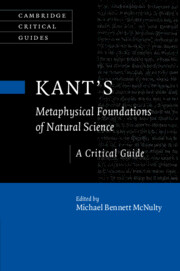Book contents
- Kant’s Metaphysical Foundations of Natural Science
- Cambridge Critical Guides
- Kant’s Metaphysical Foundations of Natural Science
- Copyright page
- Contents
- Figures
- Contributors
- Note on Abbreviations and Translations
- Introduction
- Chapter 1 Kant’s Conception of the Metaphysical Foundations of Natural Science
- Chapter 2 Kant’s Normative Conception of Natural Science
- Chapter 3 The Applicability of Mathematics as a Metaphysical Problem
- Chapter 4 Phoronomy
- Chapter 5 Space, Pure Intuition, and Laws in the Metaphysical Foundations
- Chapter 6 Finitism in the Metaphysical Foundations
- Chapter 7 The Construction of the Concept of Space-Filling
- Chapter 8 Beyond the Metaphysical Foundations of Natural Science
- Chapter 9 How Do We Transform Appearance into Experience?
- Chapter 10 Absolute Space as a Necessary Idea
- Chapter 11 Proper Natural Science and Its Role in the Critical System
- References
- Index
- Cambridge Critical Guides
Chapter 7 - The Construction of the Concept of Space-Filling
Kant’s Approach and Intentions in the Dynamics Chapter of the Metaphysical Foundations
Published online by Cambridge University Press: 22 October 2022
- Kant’s Metaphysical Foundations of Natural Science
- Cambridge Critical Guides
- Kant’s Metaphysical Foundations of Natural Science
- Copyright page
- Contents
- Figures
- Contributors
- Note on Abbreviations and Translations
- Introduction
- Chapter 1 Kant’s Conception of the Metaphysical Foundations of Natural Science
- Chapter 2 Kant’s Normative Conception of Natural Science
- Chapter 3 The Applicability of Mathematics as a Metaphysical Problem
- Chapter 4 Phoronomy
- Chapter 5 Space, Pure Intuition, and Laws in the Metaphysical Foundations
- Chapter 6 Finitism in the Metaphysical Foundations
- Chapter 7 The Construction of the Concept of Space-Filling
- Chapter 8 Beyond the Metaphysical Foundations of Natural Science
- Chapter 9 How Do We Transform Appearance into Experience?
- Chapter 10 Absolute Space as a Necessary Idea
- Chapter 11 Proper Natural Science and Its Role in the Critical System
- References
- Index
- Cambridge Critical Guides
Summary
What does Kant intend the Dynamics chapter (chapter 2) of the Metaphysical Foundations of Natural Science (MAN) to accomplish? Is there a goal specific to the Dynamics chapter? How does this aim fit into those of MAN as a whole, as described in the Preface to that work? At a first pass, we can say that the goal of MAN as a whole is the construction of the concept of matter1 and that the specific goal Kant is concerned with in the Dynamics chapter is the construction of the concept of matter as filling its space.2 But it is particularly difficult to determine what this amounts to, and how it is related to “construction,” in Kant’s technical sense.3 Moreover, there is a distinction between the goal that is specific to the Dynamics chapter, that is, the goal the chapter is concerned with, on the one hand, and what Kant says the chapter is actually meant to accomplish with regard to that goal, that is, its intended contribution toward that goal, on the other. And in order to understand this distinction, we need to ask what general claims Kant thinks he can make use of in that chapter. In this chapter I will approach these questions in three stages, which correspond to the division of the paper into Sections 7.2–7.4. First, I will discuss what Kant says in the Dynamics chapter itself about the construction under consideration there (viz., the degree of space-filling). Second, I will consider what Kant says in the Preface to MAN about the construction of the concept of matter more generally, and I will discuss how its implications (with respect to the centrality of the concept of motion) are to be understood in relation to the Dynamics chapter specifically. In the final section, which is the longest, I will examine a further law (which Kant calls the “universal law of dynamics”), which governs several crucial steps in the argumentation of the Dynamics. This law concerns the mathematical treatment of intensive magnitudes (such as the degree of space-filling) and allows us to see what Kant actually has in mind when he refers to construction in that chapter. This incorporates what he says in the Preface about construction of the concept of matter, but goes beyond anything suggested in the programmatic characterization of it given there.
- Type
- Chapter
- Information
- Kant's Metaphysical Foundations of Natural ScienceA Critical Guide, pp. 138 - 177Publisher: Cambridge University PressPrint publication year: 2022
- 1
- Cited by

